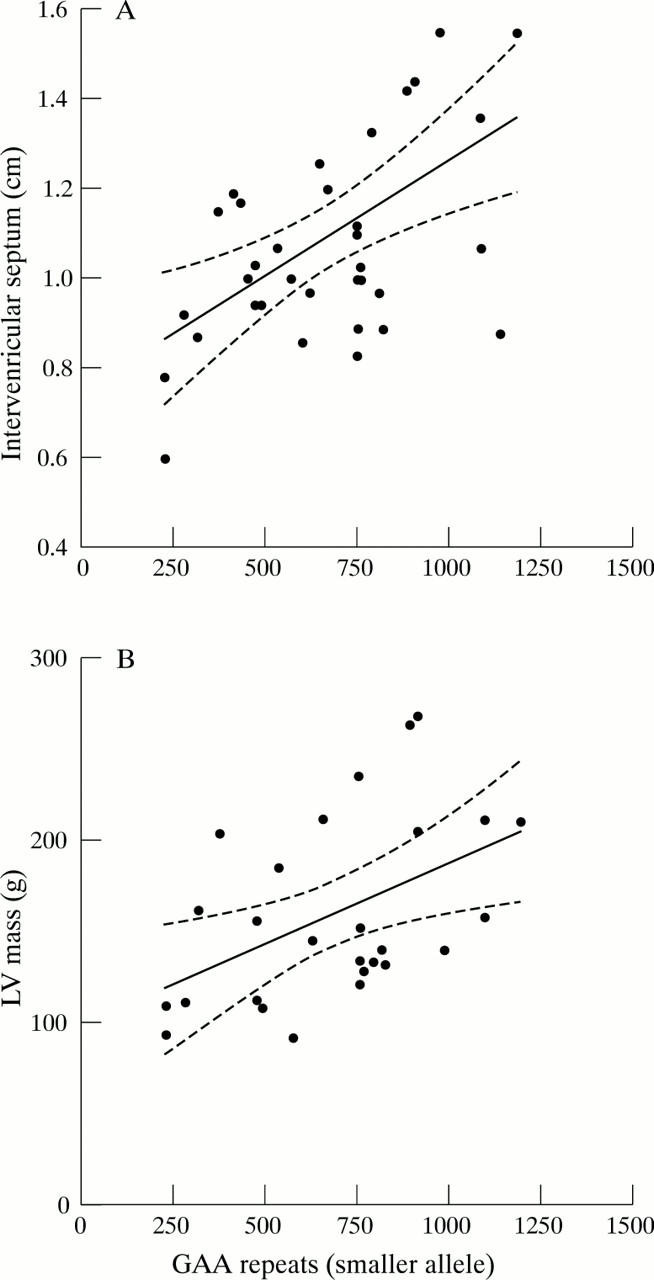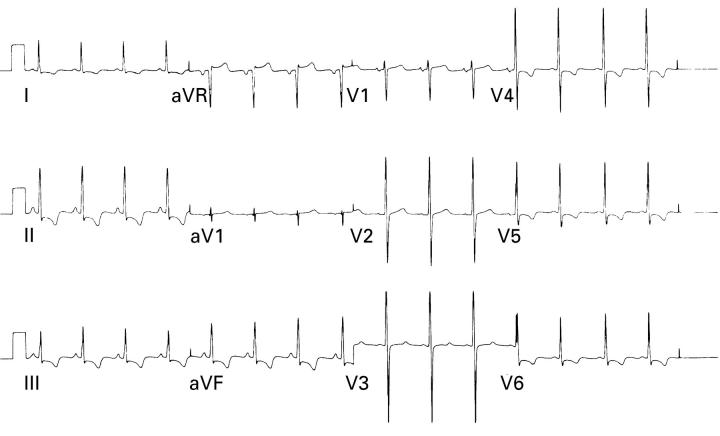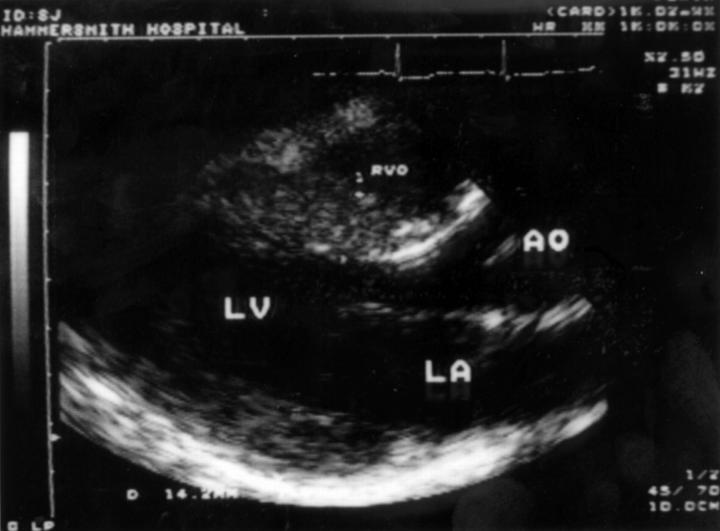Abstract
Objective—To document the cardiac phenotype associated with Friedreich's ataxia, a recessively inherited disorder characterised by spinocerebellar degeneration. Setting—Individuals with Friedreich's ataxia who accepted the invitation to participate in the study. Hypothesis—The cardiomyopathy associated with Friedreich's ataxia may offer a human model for the study of factors modulating cardiac hypertrophy. Methods—55 patients (mean (SD) age 30 (9) years) with a clinical diagnosis of Friedreich's ataxia were studied by clinical examination, electrocardiography, cross sectional and Doppler echocardiography, and analysis of the GAA repeat in the first intron of the frataxin gene. Results—A wide variety of cardiac morphology was documented. Subjects with normal frataxin alleles had no evidence of cardiomyopathy. In homozygous subjects, a relation was found between the thickness of the interventricular septum (r = 0.53, p < 0.005), left ventricular mass (r = 0.48, p < 0.01), and the number of GAA repeats on the smaller allele of the frataxin gene. No relation was shown between the presence of electrocardiographic abnormalities (mainly repolarisation changes) and either the pattern of ventricular hypertrophy (if present) and degree of neurological disability or the length of time since diagnosis. No tendency to ventricular thinning or dilatation with age was found. Although ventricular systolic function appeared impaired in some cases, Doppler studies of ventricular filling were within the normal range for age. Conclusions—The cardiomyopathy associated with Friedreich's ataxia shows a variable phenotype which is not concordant with the presence of ECG abnormalities or the neurological features of the condition. As the genetic basis for Friedreich's ataxia has been established, further studies will help to clarify the molecular mechanisms of the cardiac hypertrophy. Keywords: cardiomyopathy; Friedreich's ataxia; genetics
Full Text
The Full Text of this article is available as a PDF (148.0 KB).
Figure 1 .
Twelve lead electrocardiogram from an 18 year old patient with Friedreich's ataxia (800 and 1160 GAA repeats on the frataxin alleles), showing inferolateral T wave and deep S waves in the septal leads.
Figure 2 .
Parasternal long axis echocardiogram of the patient whose ECG is shown in fig 1, illustrating hypertrophy of the proximal interventricular septum (14.2 mm) and normal dimensions of the left ventricle (LV) and atrium (LA), aorta (AO), and right ventricular outflow (RVO).
Figure 3 .

Relation between (A) the thickness of the interventricular septum (in diastole, r = 0.53, p < 0.005), and (B) left ventricular (LV) mass (r = 0.48, p < 0.01) and the number of GAA repeats on the smaller allele of the frataxin gene in the 45 subjects homozygous for the GAA expansion. The 95% confidence intervals are shown by the dotted lines.
Selected References
These references are in PubMed. This may not be the complete list of references from this article.
- Ackroyd R. S., Finnegan J. A., Green S. H. Friedreich's ataxia. A clinical review with neurophysiological and echocardiographic findings. Arch Dis Child. 1984 Mar;59(3):217–221. doi: 10.1136/adc.59.3.217. [DOI] [PMC free article] [PubMed] [Google Scholar]
- Alboliras E. T., Shub C., Gomez M. R., Edwards W. D., Hagler D. J., Reeder G. S., Seward J. B., Tajik A. J. Spectrum of cardiac involvement in Friedreich's ataxia: clinical, electrocardiographic and echocardiographic observations. Am J Cardiol. 1986 Sep 1;58(6):518–524. doi: 10.1016/0002-9149(86)90026-3. [DOI] [PubMed] [Google Scholar]
- Alboliras E. T., Shub C., Gomez M. R., Edwards W. D., Hagler D. J., Reeder G. S., Seward J. B., Tajik A. J. Spectrum of cardiac involvement in Friedreich's ataxia: clinical, electrocardiographic and echocardiographic observations. Am J Cardiol. 1986 Sep 1;58(6):518–524. doi: 10.1016/0002-9149(86)90026-3. [DOI] [PubMed] [Google Scholar]
- Babcock M., de Silva D., Oaks R., Davis-Kaplan S., Jiralerspong S., Montermini L., Pandolfo M., Kaplan J. Regulation of mitochondrial iron accumulation by Yfh1p, a putative homolog of frataxin. Science. 1997 Jun 13;276(5319):1709–1712. doi: 10.1126/science.276.5319.1709. [DOI] [PubMed] [Google Scholar]
- Campuzano V., Montermini L., Moltò M. D., Pianese L., Cossée M., Cavalcanti F., Monros E., Rodius F., Duclos F., Monticelli A. Friedreich's ataxia: autosomal recessive disease caused by an intronic GAA triplet repeat expansion. Science. 1996 Mar 8;271(5254):1423–1427. doi: 10.1126/science.271.5254.1423. [DOI] [PubMed] [Google Scholar]
- Casazza F., Morpurgo M. Progression of hypertrophic into a dilated left ventricle in Friedreich's ataxia. G Ital Cardiol. 1988 Jul;18(7):615–618. [PubMed] [Google Scholar]
- Child J. S., Perloff J. K., Bach P. M., Wolfe A. D., Perlman S., Kark R. A. Cardiac involvement in Friedreich's ataxia: a clinical study of 75 patients. J Am Coll Cardiol. 1986 Jun;7(6):1370–1378. doi: 10.1016/s0735-1097(86)80159-0. [DOI] [PubMed] [Google Scholar]
- Cote M., Davignon A., Elias G., Solignac A., Geoffroy G., Lemieux B., Barbeau A. Hemodynamic findings in Friedreich's ataxia. Can J Neurol Sci. 1976 Nov;3(4):333–336. doi: 10.1017/s0317167100025555. [DOI] [PubMed] [Google Scholar]
- Dürr A., Cossee M., Agid Y., Campuzano V., Mignard C., Penet C., Mandel J. L., Brice A., Koenig M. Clinical and genetic abnormalities in patients with Friedreich's ataxia. N Engl J Med. 1996 Oct 17;335(16):1169–1175. doi: 10.1056/NEJM199610173351601. [DOI] [PubMed] [Google Scholar]
- Fananapazir L., Epstein N. D. Prevalence of hypertrophic cardiomyopathy and limitations of screening methods. Circulation. 1995 Aug 15;92(4):700–704. doi: 10.1161/01.cir.92.4.700. [DOI] [PubMed] [Google Scholar]
- Filla A., De Michele G., Cavalcanti F., Pianese L., Monticelli A., Campanella G., Cocozza S. The relationship between trinucleotide (GAA) repeat length and clinical features in Friedreich ataxia. Am J Hum Genet. 1996 Sep;59(3):554–560. [PMC free article] [PubMed] [Google Scholar]
- Giunta A., Maione S., Biagini R., Filla A., De Michele G., Campanella G. Noninvasive assessment of systolic and diastolic function in 50 patients with Friedreich's ataxia. Cardiology. 1988;75(5):321–327. doi: 10.1159/000174394. [DOI] [PubMed] [Google Scholar]
- Gottdiener J. S., Hawley R. J., Maron B. J., Bertorini T. F., Engle W. K. Characteristics of the cardiac hypertrophy in Friedreich's ataxia. Am Heart J. 1982 Apr;103(4 Pt 1):525–531. doi: 10.1016/0002-8703(82)90340-4. [DOI] [PubMed] [Google Scholar]
- Harding A. E. Friedreich's ataxia: a clinical and genetic study of 90 families with an analysis of early diagnostic criteria and intrafamilial clustering of clinical features. Brain. 1981 Sep;104(3):589–620. doi: 10.1093/brain/104.3.589. [DOI] [PubMed] [Google Scholar]
- Harding A. E., Hewer R. L. The heart disease of Friedreich's ataxia: a clinical and electrocardiographic study of 115 patients, with an analysis of serial electrocardiographic changes in 30 cases. Q J Med. 1983 Autumn;52(208):489–502. [PubMed] [Google Scholar]
- Hawley R. J., Gottdiener J. S. Five-year follow-up of Friedreich's ataxia cardiomyopathy. Arch Intern Med. 1986 Mar;146(3):483–488. [PubMed] [Google Scholar]
- Hentati A., Deng H. X., Hung W. Y., Nayer M., Ahmed M. S., He X., Tim R., Stumpf D. A., Siddique T., Ahmed Human alpha-tocopherol transfer protein: gene structure and mutations in familial vitamin E deficiency. Ann Neurol. 1996 Mar;39(3):295–300. doi: 10.1002/ana.410390305. [DOI] [PubMed] [Google Scholar]
- Hewer R. The heart in Friedreich's ataxia. Br Heart J. 1969 Jan;31(1):5–14. doi: 10.1136/hrt.31.1.5. [DOI] [PMC free article] [PubMed] [Google Scholar]
- Isnard R., Kalotka H., Dürr A., Cossée M., Schmitt M., Pousset F., Thomas D., Brice A., Koenig M., Komajda M. Correlation between left ventricular hypertrophy and GAA trinucleotide repeat length in Friedreich's ataxia. Circulation. 1997 May 6;95(9):2247–2249. doi: 10.1161/01.cir.95.9.2247. [DOI] [PubMed] [Google Scholar]
- Marian A. J., Mares A., Jr, Kelly D. P., Yu Q. T., Abchee A. B., Hill R., Roberts R. Sudden cardiac death in hypertrophic cardiomyopathy. Variability in phenotypic expression of beta-myosin heavy chain mutations. Eur Heart J. 1995 Mar;16(3):368–376. doi: 10.1093/oxfordjournals.eurheartj.a060920. [DOI] [PubMed] [Google Scholar]
- Maron B. J., Gardin J. M., Flack J. M., Gidding S. S., Kurosaki T. T., Bild D. E. Prevalence of hypertrophic cardiomyopathy in a general population of young adults. Echocardiographic analysis of 4111 subjects in the CARDIA Study. Coronary Artery Risk Development in (Young) Adults. Circulation. 1995 Aug 15;92(4):785–789. doi: 10.1161/01.cir.92.4.785. [DOI] [PubMed] [Google Scholar]
- Montermini L., Richter A., Morgan K., Justice C. M., Julien D., Castellotti B., Mercier J., Poirier J., Capozzoli F., Bouchard J. P. Phenotypic variability in Friedreich ataxia: role of the associated GAA triplet repeat expansion. Ann Neurol. 1997 May;41(5):675–682. doi: 10.1002/ana.410410518. [DOI] [PubMed] [Google Scholar]
- Morvan D., Komajda M., Doan L. D., Brice A., Isnard R., Seck A., Lechat P., Agid Y., Grosgogeat Y. Cardiomyopathy in Friedreich's ataxia: a Doppler-echocardiographic study. Eur Heart J. 1992 Oct;13(10):1393–1398. doi: 10.1093/oxfordjournals.eurheartj.a060072. [DOI] [PubMed] [Google Scholar]
- Rayment I., Holden H. M., Sellers J. R., Fananapazir L., Epstein N. D. Structural interpretation of the mutations in the beta-cardiac myosin that have been implicated in familial hypertrophic cardiomyopathy. Proc Natl Acad Sci U S A. 1995 Apr 25;92(9):3864–3868. doi: 10.1073/pnas.92.9.3864. [DOI] [PMC free article] [PubMed] [Google Scholar]
- Rötig A., de Lonlay P., Chretien D., Foury F., Koenig M., Sidi D., Munnich A., Rustin P. Aconitase and mitochondrial iron-sulphur protein deficiency in Friedreich ataxia. Nat Genet. 1997 Oct;17(2):215–217. doi: 10.1038/ng1097-215. [DOI] [PubMed] [Google Scholar]
- Smith E. R., Sangalang V. E., Heffernan L. P., Welch J. P., Flemington C. S. Hypertrophic cardiomyopathy: the heart disease of Friedreich's ataxia. Am Heart J. 1977 Oct;94(4):428–434. doi: 10.1016/s0002-8703(77)80035-5. [DOI] [PubMed] [Google Scholar]
- Spirito P., Seidman C. E., McKenna W. J., Maron B. J. The management of hypertrophic cardiomyopathy. N Engl J Med. 1997 Mar 13;336(11):775–785. doi: 10.1056/NEJM199703133361107. [DOI] [PubMed] [Google Scholar]
- Sutton M. G., Olukotun A. Y., Tajik A. J., Lovett J. L., Giuliani E. R. Left ventricular function in Friedreich's ataxia. An echocardiographic study. Br Heart J. 1980 Sep;44(3):309–316. doi: 10.1136/hrt.44.3.309. [DOI] [PMC free article] [PubMed] [Google Scholar]
- Sutton M. G., Olukotun A. Y., Tajik A. J., Lovett J. L., Giuliani E. R. Left ventricular function in Friedreich's ataxia. An echocardiographic study. Br Heart J. 1980 Sep;44(3):309–316. doi: 10.1136/hrt.44.3.309. [DOI] [PMC free article] [PubMed] [Google Scholar]
- Unverferth D. V., Schmidt W. R., 2nd, Baker P. B., Wooley C. F. Morphologic and functional characteristics of the heart in Friedreich's ataxia. Am J Med. 1987 Jan;82(1):5–10. doi: 10.1016/0002-9343(87)90369-x. [DOI] [PubMed] [Google Scholar]
- Unverferth D. V., Schmidt W. R., 2nd, Baker P. B., Wooley C. F. Morphologic and functional characteristics of the heart in Friedreich's ataxia. Am J Med. 1987 Jan;82(1):5–10. doi: 10.1016/0002-9343(87)90369-x. [DOI] [PubMed] [Google Scholar]
- Watkins H., McKenna W. J., Thierfelder L., Suk H. J., Anan R., O'Donoghue A., Spirito P., Matsumori A., Moravec C. S., Seidman J. G. Mutations in the genes for cardiac troponin T and alpha-tropomyosin in hypertrophic cardiomyopathy. N Engl J Med. 1995 Apr 20;332(16):1058–1064. doi: 10.1056/NEJM199504203321603. [DOI] [PubMed] [Google Scholar]
- Watkins H., Seidman J. G., Seidman C. E. Familial hypertrophic cardiomyopathy: a genetic model of cardiac hypertrophy. Hum Mol Genet. 1995;4(Spec No):1721–1727. doi: 10.1093/hmg/4.suppl_1.1721. [DOI] [PubMed] [Google Scholar]
- Weiss E., Kronzon I., Winer H. E., Berger A. R. Case report: echocardiographic observations in patients with Friedreich's ataxia. Am J Med Sci. 1981 Nov-Dec;282(3):136–140. doi: 10.1097/00000441-198111000-00007. [DOI] [PubMed] [Google Scholar]




